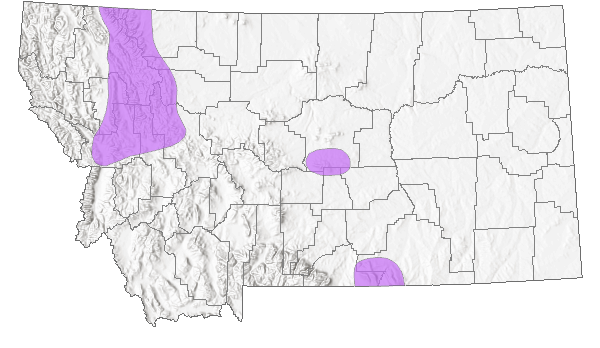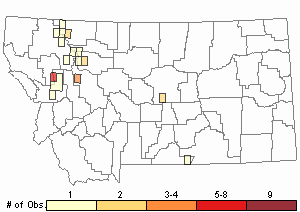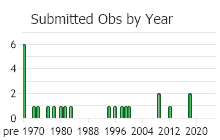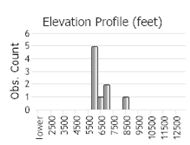View in other NatureServe Network Field Guides
NatureServe
Montana
Utah
Wyoming
Idaho
Wisconsin
British Columbia
South Carolina
Yukon
California
New York
Limestone Maidenhair Spleenwort - Asplenium trichomanes-ramosum
Other Names:
Asplenium viride
State Rank Reason (see State Rank above)
S3 SOC: Asplenium trichomanes-ramosum plants are never common, grow in habitat that is limited in Montana, and occur where land management (example: national park, wilderness) provides some protections.
- Details on Status Ranking and Review
Population Size
ScoreC - 250 - 1,000 individuals
Range Extent
ScoreF - 20,000-200,000 sq km (~8,000-80,000 sq mi)
Area of Occupancy
ScoreD - 6-25 4-km2 grid cells
Number of Populations
ScoreC - 21 - 80
Number of Occurrences or Percent Area with Good Viability / Ecological Integrity
ScoreC - Few (4-12) occurrences with excellent or good viability or ecological integrity
Environmental Specificity
ScoreB - Narrow. Specialist or community with key requirements common
Long-term Trend
ScoreU - Unknown
Trends
ScoreU - Unknown
Threats
ScoreD - Low
CommentNo known threats. Many locations occur in NPS and Wilderness where threats likely don't exist or are very low.
Intrinsic Vulnerability
ScoreU - Unknown
General Description
Plants: Semi-evergreen perennials from short, creeping, scaled rhizomes (McGregor et al. 1986) with few roots (FNA 1993); scales dark, 1-3 mm in length, lanceolate (McGregor 1986).
Leaves: Leaves frequently branched, ascending (FNA 1993), spreading, clustered (McGregor 1986), 4–15 cm long, with 6-20 pairs of pinnae (Lesica 2012); blades arching, once-pinnate, 1.5-12 cm in length, 0.5-1.3 cm in width; petioles slender and wiry, 0.3-4 cm in length, chestnut-colored proximally, becoming green, smooth or with sparse, glandular brown hairs; rachis green; pinnae nearly opposite to alternate, 2-6 mm in length, obovate, short-stalked or nearly sessile, with toothed margins (McGregor et al. 1986) or distal margins crenate (FNA 1993)
(P. Lesica's contribution adapted from
Lesica et al. 2012. Manual of Montana Vascular Plants. BRIT Press. Fort Worth, TX)
Phenology
June-September (McGregor et al. 1986).
Species Range
Montana Range
Range Descriptions

 Native
Native
Range Comments
Circumboreal, extending south in scattered localities (Lesica 2012), including Greenland; AB, BC, NB, NL, NT, NS, ON, PE, QC, YT; AK, CA, CO, ID, ME, MI, MT, NV, NY, OR, SD, UT, VT, WA, WI, WY (FNA 1993). Known in Montana from some northwestern counties and is disjunct in Fergus County (Lesica 2012).
(Lesica's contribution adapted from Lesica et al. 2012. Manual of Montana Vascular Plants. BRIT Press. Fort Worth, TX)
Observations in Montana Natural Heritage Program Database
Number of Observations: 34
(Click on the following maps and charts to see full sized version)
Map Help and Descriptions
Relative Density

Recency



 (Observations spanning multiple months or years are excluded from time charts)
(Observations spanning multiple months or years are excluded from time charts)
Habitat
Shaded basic rocks (FNA 1993), including moist to wet limestone crevices; montane to alpine (Lesica 2012).
(Lesica's contribution adapted from
Lesica et al. 2012. Manual of Montana Vascular Plants. BRIT Press. Fort Worth, TX)
National Vegetation Classification System Groups Associated with this Species
Alpine
Alpine - Sparse and Barren
Sparse and Barren
Sparse and Barren
Reproductive Characteristics
Sori: Sori 4 to 8 per pinna (Lesica 2012), blending into each other with age, median, elliptic (McGregor 1986), narrow, 2-3 mm in length (Douglas et al. 2000); the indusia connected to the upper side of the pinna’s veinlet (McGregor et al. 1986).
(P. Lesica's contribution adapted from
Lesica et al. 2012. Manual of Montana Vascular Plants. BRIT Press. Fort Worth, TX)
Stewardship Responsibility
Threats or Limiting Factors
STATE THREAT SCORE REASON
Threat impact not assigned because threats are not known (MTNHP Threat Assessment 2021).
References
- Literature Cited AboveLegend:
 View Online Publication
View Online Publication Douglas, G.W., D. Meidinger, and J. Pojar, editors. 2000. The Illustrated Flora of British Columbia. Volume 5. Dicotyledons (Salicaceae through Zygophyllaceae) and Pteridophytes. British Columbia Ministry of Environment, Lands and Parks and British Columbia Ministry of Forests, Victoria.
Douglas, G.W., D. Meidinger, and J. Pojar, editors. 2000. The Illustrated Flora of British Columbia. Volume 5. Dicotyledons (Salicaceae through Zygophyllaceae) and Pteridophytes. British Columbia Ministry of Environment, Lands and Parks and British Columbia Ministry of Forests, Victoria. Flora of North America Editorial Committee, eds. 1993. Flora of North America North of Mexico. Volume 2. Pteridophytes and Gymnosperms. Oxford University Press, Inc., NY. xvi + 475 pp.
Flora of North America Editorial Committee, eds. 1993. Flora of North America North of Mexico. Volume 2. Pteridophytes and Gymnosperms. Oxford University Press, Inc., NY. xvi + 475 pp. Lesica, P., M.T. Lavin, and P.F. Stickney. 2012. Manual of Montana Vascular Plants. Fort Worth, TX: BRIT Press. viii + 771 p.
Lesica, P., M.T. Lavin, and P.F. Stickney. 2012. Manual of Montana Vascular Plants. Fort Worth, TX: BRIT Press. viii + 771 p. McGregor, R.L. (coordinator), T.M. Barkley, R.E. Brooks, and E.K. Schofield (eds). 1986. Flora of the Great Plains: Great Plains Flora Association. Lawrence, KS: Univ. Press Kansas. 1392 pp.
McGregor, R.L. (coordinator), T.M. Barkley, R.E. Brooks, and E.K. Schofield (eds). 1986. Flora of the Great Plains: Great Plains Flora Association. Lawrence, KS: Univ. Press Kansas. 1392 pp. MTNHP Threat Assessment. 2021. State Threat Score Assignment and Assessment of Reported Threats from 2006 to 2021 for State-listed Vascular Plants. Botany Program, Montana Natural Heritage Program, Helena, Montana.
MTNHP Threat Assessment. 2021. State Threat Score Assignment and Assessment of Reported Threats from 2006 to 2021 for State-listed Vascular Plants. Botany Program, Montana Natural Heritage Program, Helena, Montana.
- Additional ReferencesLegend:
 View Online Publication
View Online Publication
Do you know of a citation we're missing? Britton, N. L. and A. B. Brown. 1913. An Illustrated Flora of the Northern United States, Canada, and the British Possessions. 2nd Edition in 3 Volumes. New York, NY: Charles Scribner's Sons. B13BRI01PAUS.
Britton, N. L. and A. B. Brown. 1913. An Illustrated Flora of the Northern United States, Canada, and the British Possessions. 2nd Edition in 3 Volumes. New York, NY: Charles Scribner's Sons. B13BRI01PAUS. Lesica, P., M.T. Lavin, and P.F. Stickney. 2022. Manual of Montana Vascular Plants, Second Edition. Fort Worth, TX: BRIT Press. viii + 779 p.
Lesica, P., M.T. Lavin, and P.F. Stickney. 2022. Manual of Montana Vascular Plants, Second Edition. Fort Worth, TX: BRIT Press. viii + 779 p.
- Web Search Engines for Articles on "Limestone Maidenhair Spleenwort"





